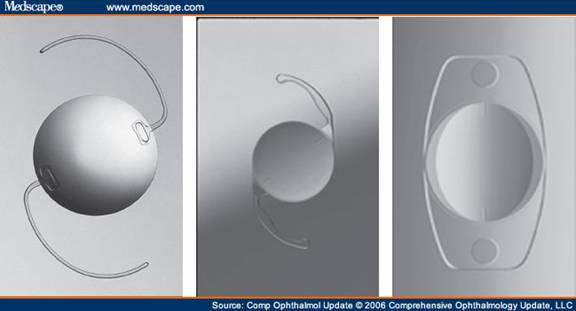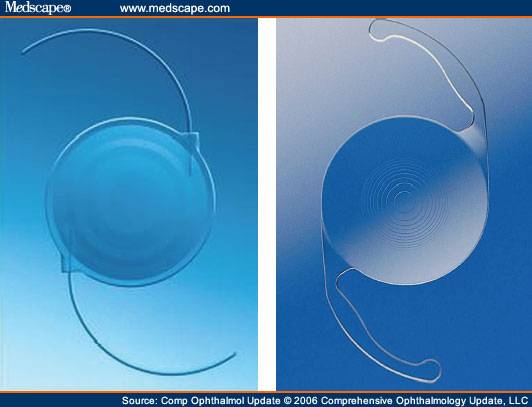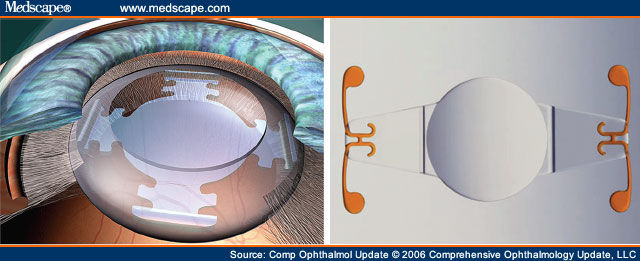| Cataract Surgery and Intraocular Lens Technology |
IOL Design
Previous generation IOLs are monofocal (far, intermediate, or near) but many advances have been made for accomdation of vision restoration and lens shape. The new multifocal and accommodating IOLs offer the possibility of seeing well at more than one distance, without glasses or contacts. The following are a few designs and technologies currently clinically implanted:
- Intraocular lens designs with advanced optical performance

Left: Tecnis IOL. The Tecnis intraocular lens technology is designed in consideration of the average positive spherical aberration introduced by the cornea, which is partially corrected by compensating negative spherical aberration introduced by the crystalline lens. Negative spherical aberration of the lens decreases with age, which ultimately results in greater spherical abberations of the whole lens. The Tecnis IOL is designed with a modified with both negative spherical abberation and a prolate-front surface with negative spherical abberations. Middle: Alcon toric IOL. This IOL is a hydrophobic acrylic lens is based on a previous design called the AcrySof® single-piece IOL and was available in 1.5, 2.25, and 3.0 diopters of cylinder power. Right: Staar Toric IOL. This IOL is composed of a silicone-plate surface with variable lengths, providing 2.0 diopters and 3.5 diopters of cylinder power.
- Schematic illustration of the mechanism of action of the light adjustable lens (LAL™)

The LAL IOL is based on a photosensitive silicone design that is activated noninvasively and cured after implantation using a low light source. Simply put, the LAL was designed with a cross-linked silicone polymer matrix with an overlying photosensitive macromer. Either UV light or any low power light source can be exposed to a certain region of the lens (A) which will intiate polymerization of the photosensitive macromer (B). Nonpolymerized macromers from the nonirradiated areas will then migrate to the polymerized (irradiated) area (C), leading to precise changes in the thickness and power of the intraocular lens (D).
- Multifocal intraocular lens designs

Left: Array IOL designed by Advanced Medical Optics. The Array is designed with a multifocal refractive lens made of silicone, the firstposterior chamber intraocular lens to be approved in the United States (1998). The haptics are made of 6-mm optic and poly(methyl) methacrylate. This design has also been modified with advanced optical zones and is manufactured from a hydrophobic acrylic polymer. Right: AcrySof® ReSTOR® intraocular lens. This AcrySof-based multifocal lens is composed of a hybrid apodized diffractive/refractive optic made from a single piece IOL.
- Single-optic accommodative lens designs

Left: Akkommodative 1CU intraocular IOL. Though only avaibale in the internation market, this lens is composed of a one-piece hydrophilic acrylic lens with a optical diameter of 5.5mm and overall diameter of 9.8mm. The unconventional haptic design act as hinges taht allow for antero-posterior movement. Right: Crystalens AT-45 IOL. The Crystalens AT-45 (4.5 mm)siliconeintraocular lens is essentially a single-optic accommodative IOL that is designed with hinged haptics, measuring 11.5 mm in overall size. For this deisng also, the new haptics are designed to allow for antero-posterior mobility. In addition, more stable anchorage in the lens is achieved with the polyimide loops to adhere to the capsule.
All Right Reserved © 2007 by H Sin